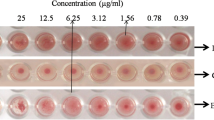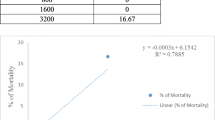Abstract
This study explored the efficacy of Fa fraction of Tricholoma giganteum against Ehrlich’s ascites carcinoma (EAC). Mechanisms of apoptogenic effect of the fraction were delineated. The flow cytometric analysis of EAC cells, showed an increase in number of cells in sub-G0/G1 population and reduction in the G2/M phase due to the treatment thus suggesting apoptosis. The induction of apoptosis has also been confirmed by nuclear staining that demonstrated distinctive morphological features of apoptosis. Our data also revealed an increase in the expression of pro-apoptotic protein p53 in EAC and induced factors contributing to apoptosis. Pro-apoptotic gene Bax was up-regulated during p53-mediated apoptosis. No significant change in the expression of anti-apoptotic protein Bcl-2 was observed ensuing in decrease of the Bcl-2/Bax ratio. p53-mediated growth arrest involves p21 as a major effecter, which interestingly showed moderate elevation. All these observations indicate that Fa fraction of T. giganteum induces apoptogenic signal in EAC.




Similar content being viewed by others
Abbreviations
- AP:
-
Alkaline phosphatase
- BCIP:
-
Bromochloroindolyl phosphate
- DAPI:
-
4′,6′-Diamidino-2-phenylindole
- dNTP:
-
Deoxynucleoside triphosphates
- DTT:
-
Dithiothreitol
- EAC:
-
Ehrlich’s ascites carcinoma
- FACS:
-
Fluorescence-activated cell sorter
- FITC:
-
Fluorescein isothiocyanate
- NBT:
-
Nitrobluetetrazolium
- PBS:
-
Phosphate buffered saline,
- PI:
-
Propidium iodide
- RT-PCR:
-
Reverse transcription-polymerase chain reaction
- SDS:
-
Sodium dodecyl sulfate
References
Pal S, Choudhuri T, Chattopadhyay S, Bhattacharya A, Datta GK, Das T, Sa G (2001) Mechanism of curcumin-induced apoptosis of Ehrlich’s ascites carcinoma cells. Biochem Biophys Res Commun 288:658–665
Parnes HL, Thompson IM, Ford LG (2005) Prevention of hormone-related cancers: prostate cancer. J Clin Oncol 23:368–377
Ayodele SM, Okhuoya JA (2009) Nutritional and phytochemical evaluation of cultivated Psathyrella atroumbonata Pegler, a Nigerian edible mushroom. S Afr J Sci 105:158–160
Wasser SP, Weiss AL (1999) Medicinal properties of substances occurring in higher Basidiomycetes mushrooms: current perspectives. Int J Med Mushrooms 1:31–62
Acharya K (2007) Medicinal properties of mushroom. In: Acharya SN, Thomas JE (eds) Advances in medicinal plant research. Research Signpost, Kerala, pp 215–236
Biswas G, Sarkar S, Acharya K (2010) Free radical scavenging and anti-inflammatory activities of the extracts of Astraeus hygrometricus (Pers.) Morg. Lat Am J Pharm 29:549–553
Biswas G, Rana S, Sarkar S, Acharya K (2011) Cardioprotective activity of ethanolic extract of Astraeus hygrometricus (Pers.) Morg. Pharmacologyonline 2:808–817
Biswas G, Sarkar S, Acharya K (2011) Hepatoprotective activity of the ethanolic extract of Astraeus hygrometricus (Pers.) Morg. Dig J Nanomater Bios 6:637–641
Chatterjee S, Dey A, Dutta R, Dey S, Acharya K (2011) Hepatoprotective effect of the ethanolic extract of Calocybe indica on mice with CCl4 − hepatic intoxication. Int J PharmTech Res 3:2162–2168
Chatterjee S, Biswas G, Basu SK, Acharya K (2011) Antineoplastic effect of mushrooms: a review. Aust J Crop Sci 5:904–911
Choi YH, Choi BT, Lee WH, Rhee SH, Park KY (2001) Doenjang hexane fraction-induced G1 arrest is associated with the inhibition of pRB phosphorylation and induction of Cdk inhibitor p21 in human breast carcinoma MCF-7 cells. Oncol Rep 8:1091–1096
Yee KS, Vousden KH (2005) Complicating the complexity of p53. Carcinogenesis 26:1317–1322
Miyashita T, Reed JC (1995) Tumor suppressor p53 is a direct transcriptional activator of the human Bax gene. Cell 80:293–299
Bhattacharya A, Choudhuri T, Pal S, Chattopadhyay S, Datta GK, Sa G, Das T (2003) Apoptogenic effects of black tea on Ehrlich’s ascites carcinoma cell. Carcinogenesis 24:75–80
Borchers AT, Keen CI, Gershwin MF (2004) Mushroom, tumors and immunity: an update. Exp Biol Med 229:393–406
Chatterjee S, Saha GK, Acharya K (2011) Antioxidant activities of extracts obtained by different fractionation from Tricholoma giganteum basidiocarps. Pharmacologyonline 3:88–97
Cui Y, Kim DS, Park KC (2005) Antioxidant effect of Inonotus obliquus. J Ethnopharmacol 96:79–85
Das T, Sa G, Chattopadhyay S, Ray PK (2002) Protein A-induced apoptosis of cancer cells is effected by soluble immune mediators. Cancer Immunol Immunother 51:376–380
Manna S, Banerjee S, Mukherjee S, Das S, Panda CK (2006) Epigallocatechin gallate induced apoptosis in Sarcoma 180 cells in vivo: mediated by p53 pathway and inhibition in U1B, U4–U6 UsnRNAs expression. Apoptosis 11:2267–2276
Choudhuri T, Pal S, Agwarwal M, Das T, Sa G (2002) Curcumin induces apoptosis in human breast cancer cells through p53-dependent Bax induction. FEBS Lett 512:334–340
Aravind SR, Joseph MM, Varghese S, Balaram P, Sreelekha TT (2012) Polysaccharide PST001 isolated from the seed kernel of Tamarindus indica induces apoptosis in murine cancer cells. Int J Life Sci Pharm Res 2:159–172
Zaidman BZ, Yassin M, Mahajna J, Wasser SP (2005) Medicinal mushroom modulators of molecular targets as cancer therapeutics. Appl Microbiol Biotechnol 67:453–468
Malik A, Afaq F, Sarfaraz S, Adhami VM, Syed DN, Mukhtar H (2005) Pomegranate fruit juice for chemoprevention and chemotherapy of prostate cancer. Proc Natl Acad Sci 102:14813–14818
Villunger A, Egle A, Kos M, Hartmann BL, Geley S, Kofler R, Greil R (1997) Drug-induced apoptosis is associated with enhanced Fas (Apo-1/(CD95) signaling in human T-acute lymphatic leukemia cells. Cancer Res 57:3331–3334
Chinni SR, Li Y, Upadhyay S, Koppolu PK, Sarkar FH (2001) Indole-3-carbinol (I3C) induced cell growth inhibition, G1 cell cycle arrest and apoptosis in prostate cancer cells. Oncogene 20:2927–2936
Helt CE, Rancourt RC, Staversky RJ, O’Reilly MA (2001) p53-dependent induction of p21 (Cip1/WAF-1/Sdi1) protects against oxygen induced toxicity. Toxicol Sci 63:214–222
Strobel T, Swanson L, Korsmeyer S, Cannistra SA (1996) Bax enhances paclitaxel-induced apoptosis through a p53-independent pathway. Proc Natl Acad Sci 93:14094–14099
Acknowledgments
The financial support of the University Grants Commission-Research Fellowship in Science for Meritorious Students (UGC-RFSMS), New Delhi, is gratefully acknowledged.
Author information
Authors and Affiliations
Corresponding author
Rights and permissions
About this article
Cite this article
Chatterjee, S., Biswas, G., Chandra, S. et al. Apoptogenic effects of Tricholoma giganteum on Ehrlich’s ascites carcinoma cell. Bioprocess Biosyst Eng 36, 101–107 (2013). https://doi.org/10.1007/s00449-012-0765-6
Received:
Accepted:
Published:
Issue Date:
DOI: https://doi.org/10.1007/s00449-012-0765-6




